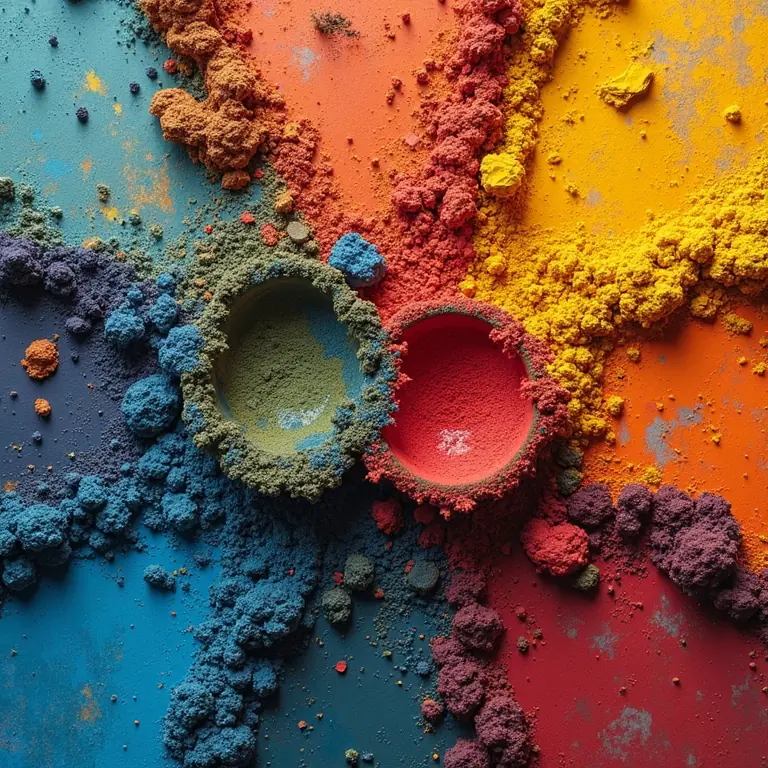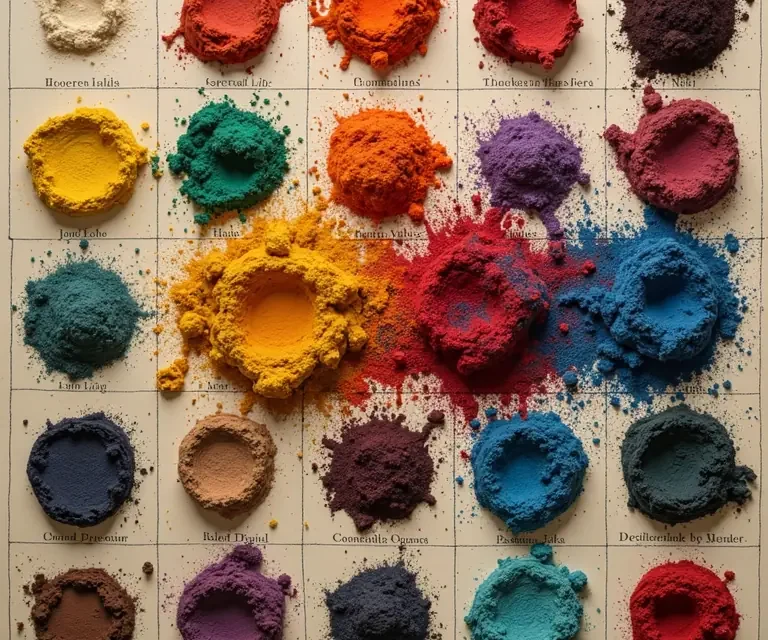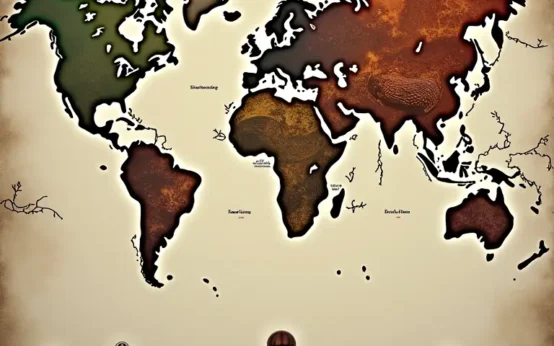Color is everywhere. It shapes our perceptions, influences our emotions, and permeates our history. But have you ever stopped to consider *where* color comes from? Beyond the simple answer of “things reflecting light,” lies a fascinating world of chemistry, geology, and cultural exchange centered around one key element: pigments. This article will take you on a journey through time, exploring the surprising science of pigments and how they’ve shaped civilizations.
What Exactly *Is* a Pigment?
At its core, a pigment is a material that imparts color by selectively absorbing and reflecting certain wavelengths of light. Unlike dyes, which dissolve into the material they color, pigments remain as solid particles. Think of the difference between adding food coloring to water (dye) versus stirring flour into it (pigment). That’s a simplified analogy, of course! The chemistry is far more complex.
Pigments can be derived from various sources – natural minerals, plants, and even animals. Synthetic pigments, developed through chemical processes, have expanded the color palette dramatically, particularly in the last two centuries. The ability of a pigment to hold its color, resist fading (lightfastness), and interact with the medium it’s mixed with (its vehicle – like oil, water, or acrylic) are crucial properties.
The Dawn of Color: Prehistoric Pigments
Our fascination with color stretches back to the very beginnings of humanity. The earliest known use of pigments dates back over 100,000 years! Evidence from caves like those in Blombos Cave, South Africa, shows ochre – a naturally occurring earth pigment containing iron oxide – being used for body painting and symbolic expression. Ochre produces shades of red, yellow, and brown, and was readily available in many parts of the world.
These early pigments weren’t just about aesthetics. They likely served ritualistic purposes, perhaps signifying status, clan affiliation, or spiritual beliefs. The famous cave paintings of Lascaux and Altamira, created around 40,000 years ago, demonstrate remarkable skill in utilizing pigments like ochre, charcoal (black), and manganese dioxide (black and purple) to depict animals and scenes of daily life. Grinding these materials into a fine powder, mixing them with binders like animal fat or plant juices, and applying them to the cave walls was a laborious but clearly important process.
Ancient Civilizations: Expanding the Palette
As civilizations arose, so did the demand for more diverse and vibrant colors. Ancient Egyptians were masters of pigment creation. They developed Egyptian Blue, the first synthetic pigment, around 2200 BC. This stunning blue was made by heating limestone, sand, and copper-containing minerals. It adorned tombs, statues, and jewelry, symbolizing the sky and the Nile River.
The Egyptians also utilized malachite (green), derived from copper ore, and cinnabar (red), a mercury sulfide mineral. Cinnabar, while beautiful, was highly toxic, a risk early pigment makers were often unaware of. They also imported lapis lazuli, a deep blue gemstone from Afghanistan, prized for its intense color and used extensively in royal art.
In ancient Greece and Rome, pigments like ochre, charcoal, and white (from chalk or gypsum) were common. However, they also imported pigments from across their vast empires. Purple dye, extracted from the murex sea snail, was incredibly expensive and reserved for royalty and high-ranking officials – hence its association with power and wealth. The Romans also experimented with lead-based pigments, like lead white, which offered excellent coverage but also posed significant health risks.
The Medieval Period: Manuscripts and Majesty
The Middle Ages saw a flourishing of pigment production, particularly driven by the creation of illuminated manuscripts. Monasteries became centers of artistic and scientific learning, and monks meticulously crafted pigments from various sources. Lapis lazuli remained highly valued, its price often exceeding that of gold. Ultramarine, the pigment derived from lapis lazuli, became the most prized blue, reserved for depicting the robes of the Virgin Mary and other sacred figures.
Other important medieval pigments included vermilion (red, derived from cinnabar), malachite and azurite (blues and greens), and orpiment and realgar (yellows and oranges, both arsenic-based and highly toxic). The creation of these pigments was often a closely guarded secret, passed down through generations of artisans. This period also saw the development of techniques for grinding and mixing pigments to achieve specific shades and textures. Interested in the evolution of recording information? You might find a history of writing technologies fascinating.
The Renaissance: A Revolution in Color
The Renaissance witnessed a renewed interest in classical art and learning, and a corresponding revolution in pigment technology. Artists like Leonardo da Vinci and Michelangelo experimented with new materials and techniques to achieve greater realism and expressive power. The discovery of new pigment sources and the refinement of existing ones expanded the color palette significantly.
Venetian painters, in particular, were renowned for their mastery of color. They pioneered the use of oil painting, which allowed for greater blending and layering of pigments. The development of lead-tin yellow, a vibrant and durable yellow pigment, was a major breakthrough. However, the use of toxic pigments continued to be a concern. Artists often suffered from lead poisoning and other health problems due to their exposure to these materials.

The 18th and 19th Centuries: The Rise of Synthetic Pigments
The 18th and 19th centuries marked a turning point in pigment history with the advent of synthetic pigments. Prior to this, all pigments were derived from natural sources, limiting the range of available colors and often making them expensive and difficult to obtain. The development of chemistry allowed scientists to create pigments in the laboratory, offering a wider spectrum of colors and greater control over their properties.
Prussian blue, discovered accidentally in 1706, was the first modern synthetic pigment. It was a relatively inexpensive and stable blue, quickly becoming popular among artists. In the 19th century, a series of groundbreaking discoveries led to the creation of a wide range of new synthetic pigments, including chrome yellow, cadmium yellow, and cobalt blue. These pigments offered artists unprecedented freedom and versatility.
The 20th and 21st Centuries: Safety and Innovation
The 20th century brought increased awareness of the health risks associated with certain pigments, particularly those containing heavy metals. Many traditional pigments, like lead white and chrome yellow, were found to be toxic and were gradually replaced by safer alternatives. This led to a renewed focus on developing non-toxic and environmentally friendly pigments.
The development of organic pigments, derived from carbon-based compounds, offered a viable alternative to many inorganic pigments. These pigments are often brighter and more transparent than their inorganic counterparts. Furthermore, advancements in nanotechnology have led to the creation of new pigments with unique properties, such as enhanced lightfastness and color intensity. The search for sustainable and ethically sourced pigments is also gaining momentum, driven by environmental concerns and a growing awareness of social responsibility. Understanding the underlying principles of these materials can also reveal fascinating connections to mathematics – explore the geometry of everyday objects to see how shape and structure influence our world.
Pigments Beyond Art: Applications in Everyday Life
While often associated with art, pigments are integral to countless aspects of modern life. They’re used in paints, coatings, plastics, textiles, cosmetics, and even food coloring. The automotive industry relies heavily on pigments to create vibrant and durable car finishes. The construction industry uses pigments to color concrete, roofing tiles, and other building materials.
The development of specialized pigments with unique properties has led to innovations in various fields. For example, thermochromic pigments change color with temperature, while photochromic pigments change color with light. These pigments are used in a wide range of applications, from novelty items to security features. Even the toys our children play with rely on pigment technology – you might be surprised by the physics behind play!
The Geological Roots of Pigments
Many of the earliest and still widely used pigments come directly from the Earth. Minerals like iron oxides (ochre, sienna, umber), manganese oxides, and various clays provide a foundational range of colors. The formation of these minerals is a complex geological process, often involving volcanic activity, weathering, and sedimentation.
The specific composition of these minerals determines their color. For example, iron oxide with a higher proportion of iron produces a redder hue, while a lower proportion results in a yellower shade. Understanding the geological origins of pigments provides valuable insights into the Earth’s history and the processes that shape our planet. Delve deeper into the secret lives of common minerals to appreciate their hidden complexity.
The Future of Pigments
The future of pigments is likely to be driven by sustainability, innovation, and a growing demand for specialized applications. Researchers are exploring new sources of pigments, including microorganisms and waste materials. The development of bio-based pigments, derived from renewable resources, is a promising area of research.
Nanotechnology will continue to play a crucial role in creating pigments with enhanced properties. The ability to control the size and shape of pigment particles at the nanoscale level will allow for even greater precision in color control and performance. Furthermore, the development of smart pigments that respond to external stimuli, such as temperature, light, or pressure, will open up new possibilities for a wide range of applications. Even seemingly mundane things, like the names of our streets, can tell a story – discover untold stories in street names!
The story of pigments is a testament to human ingenuity and our enduring fascination with color. From the ochre paintings of our ancestors to the vibrant hues of modern art and technology, pigments have shaped our world in countless ways. As we continue to explore the science of color, we can expect even more exciting discoveries and innovations in the years to come.


 The Curious Acoustics of Historical Echo Chambers: Resonance, Ritual, and Revelation
The Curious Acoustics of Historical Echo Chambers: Resonance, Ritual, and Revelation  The Curious Cartography of Scent: Mapping Perfume Ingredients Through History
The Curious Cartography of Scent: Mapping Perfume Ingredients Through History  The Curious Lexicon of Lost Trades
The Curious Lexicon of Lost Trades  The Surprisingly Consistent Science of Historical Ice Harvesting – A Frozen History of Commerce & Preservation
The Surprisingly Consistent Science of Historical Ice Harvesting – A Frozen History of Commerce & Preservation  The Unexpectedly Consistent Science of Historical Buttonhooks – Fashion, Function & Forgotten Tools
The Unexpectedly Consistent Science of Historical Buttonhooks – Fashion, Function & Forgotten Tools  The Surprisingly Consistent Science of Historical Toy Soldiers – Miniature Warfare, Materials & Collective Play
The Surprisingly Consistent Science of Historical Toy Soldiers – Miniature Warfare, Materials & Collective Play